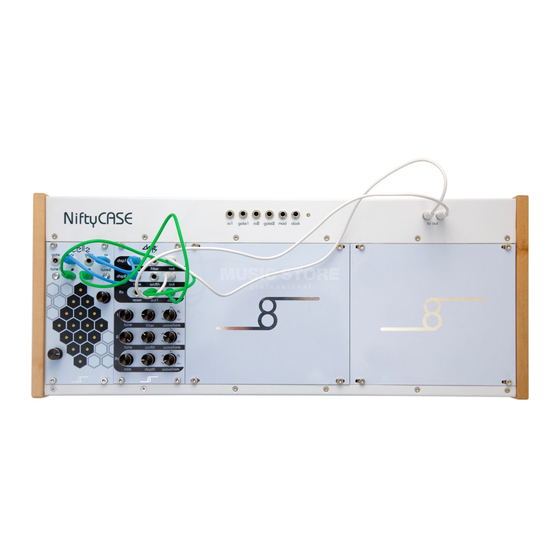
Advertisement
Quick Links
Checking connections
Welcome to NiftyCASE! Before powering your NiftyCASE for the first time we
recommend checking that everything is in order connection-wise and that nothing has
moved during transit.
Carefully unscrew and remove any modules and blank panels with the included Allen
key and ensure that the IDC bus cable is firmly connected to the mainboard. Check that
the smaller FFC flat cable (then one between the main board and I/O connector
circuitboard) is also firmly in place. Reseat the cable(s) if necessary.
Here is a video about checking connections
https://www.cre8audio.com/checking-connections
User Manual
Updated April 14th 2021
Advertisement

Summary of Contents for cre8audio NiftyCASE
- Page 1 User Manual Updated April 14th 2021 Checking connections Welcome to NiftyCASE! Before powering your NiftyCASE for the first time we recommend checking that everything is in order connection-wise and that nothing has moved during transit. Carefully unscrew and remove any modules and blank panels with the included Allen key and ensure that the IDC bus cable is firmly connected to the mainboard.
- Page 2 Installing modules Always turn off NiftyCASE before adding or removing modules. Handling modules that are powered can lead to damage. Observe the following picture for the correct cable orientation. The red line on the cables should always match (facing down).
-
Page 3: Quick Start
1. Step 6: Play away! The NiftyCASE led will blink as you press keys, and the cv1 output voltage will change as new notes are sent from your MIDI keyboard, the tune/pitch of chipz will update accordingly. - Page 4 DAW. In this quick start we’ll suppose that you are using our chipz module, controlled by Ableton Live. NiftyCASE has a built-in USB to MIDI/CV converter so only a USB cable is required to make the connection between NiftyCASE and your computer.
- Page 5 Step 6: Let’s Assign a MIDI track to NiftyCASE channel1 (as per above right screenshot). Change the “MIDI To” to Cre8audioNiftyCASE And set the channel to Ch. 1 Step 7: Sequence party time! The NiftyCASE led will blink as new notes are received from Live.
- Page 6 Mod (aka modulation wheel) output This output transmits a variable control voltage (CV) ranging from 0V to 10V. This output responds to MIDI CC#1 (mod wheel) transmitted to NIftyCASE on MIDI channel 1. Refer to the MIDI implementation below for more details.
- Page 7 Status LED The LED serves 2 purposes: to indicate power to NiftyCASE and incoming MIDI. The LED will stay lit when NiftyCASE is powered and in standby, and will briefly blink when MIDI is received. NiftyTIP: When MIDI clock is received the status LED will conveniently blink on every 1/8th of a bar and can therefore be used as a visual metronome.
- Page 8 Midi in Connect a MIDI keyboard or sequencer to this DIN5 port to take control of NiftyCASE. NiftyCASE will also send midi information received out of the “midi thru” port so you can daisy chain MIDI devices. The USB port is used to control NiftyCASE via MIDI-over-USB. Use a USB type B cable to connect NIftyCASE to a computer.
-
Page 9: Midi Implementation
MIDI Implementation Send MIDI information to NiftyCASE to control its outputs. NiftyCASE will respond identically to MIDI received both at the “midi in” DIN5 jack and via USB (from a computer/DAW). The MIDI messages are handled differently depending on the MIDI channel: MIDI Channel 1 - CV1/GATE1 monophonic MIDI channel 1 will control cv1 and gate1. - Page 10 Cv1 and cv2 both output a voltage according to the 1V per octave standard: MIDI note CV1/2 Voltage output CV1/2 Voltage output Default Firmware Alternate firmware with -2V offset...
- Page 11 NiftyCASE uses the highest-note priority on both channels as illustrated below: MIDI Channel 10 - drum mode MIDI received on channel 10 turns NiftyCASE into a 5 channel drum trigger machine. In this special mode the first 5 top jacks behave as gates (closed=0V open=5V) This mode can be used to trigger drum modules, advance sequencers or other percussive modules.
-
Page 12: Frequently Asked Questions
Q. Is the out balanced or unbalanced? A. It’s unbalanced (just like us) Q. NiftyCASE is not showing up on my Mac with USB C when using with a 3rd party adapter/dongle… What’s up with that? A. We’ve discovered that not all USB C hubs and adapters are created equal. Apple branded ones do seem to work consistently. - Page 13 A. We have found that some older MacBooks (specifically i7 processor-equipped from around 2012) need a powered USB hub to operate with NiftyCASE. Q. Will NiftyCASE make me some pizza? A. Sadly no.

Need help?
Do you have a question about the NiftyCASE and is the answer not in the manual?
Questions and answers